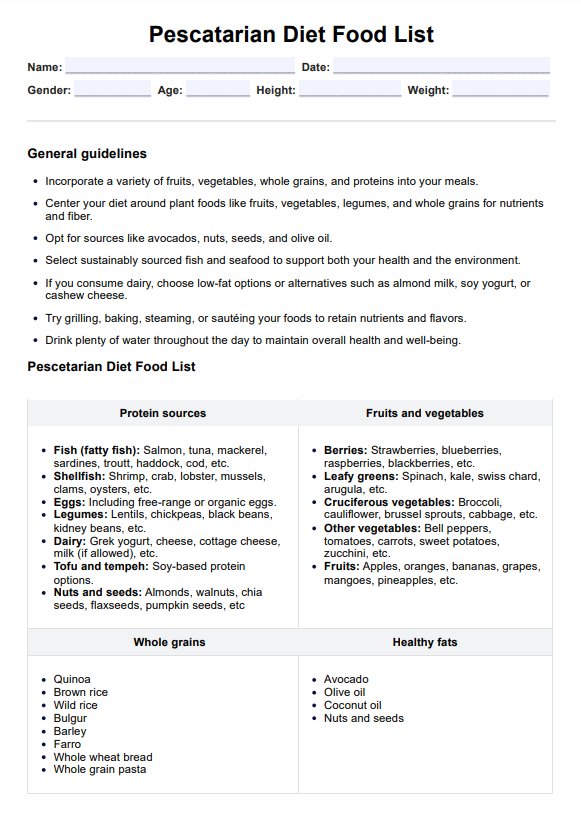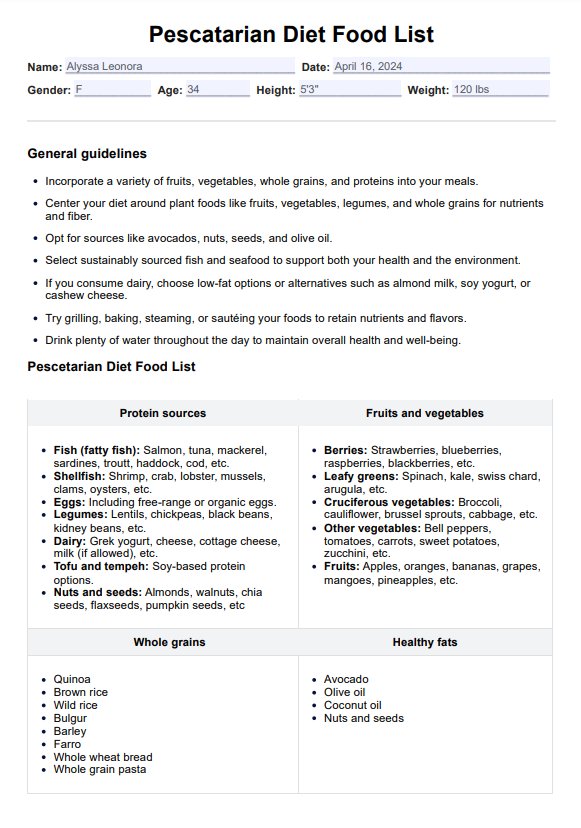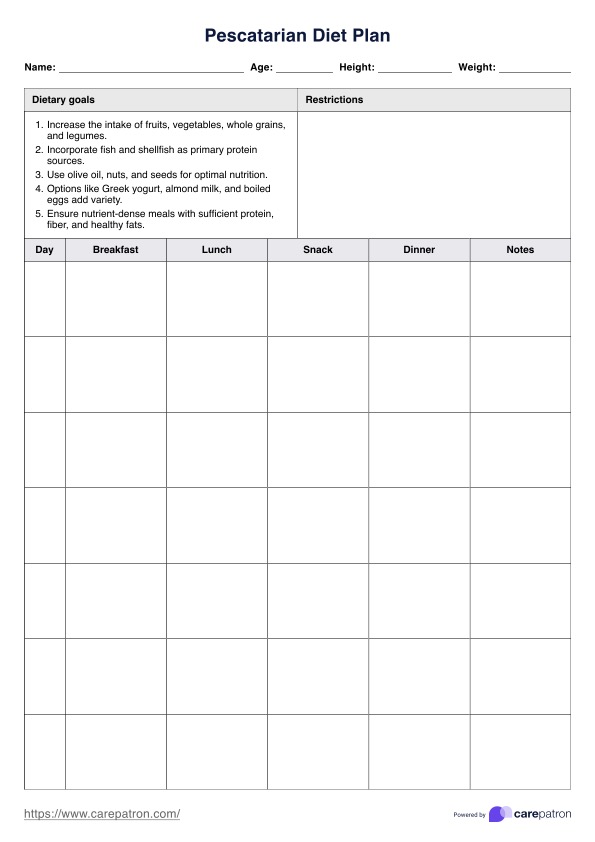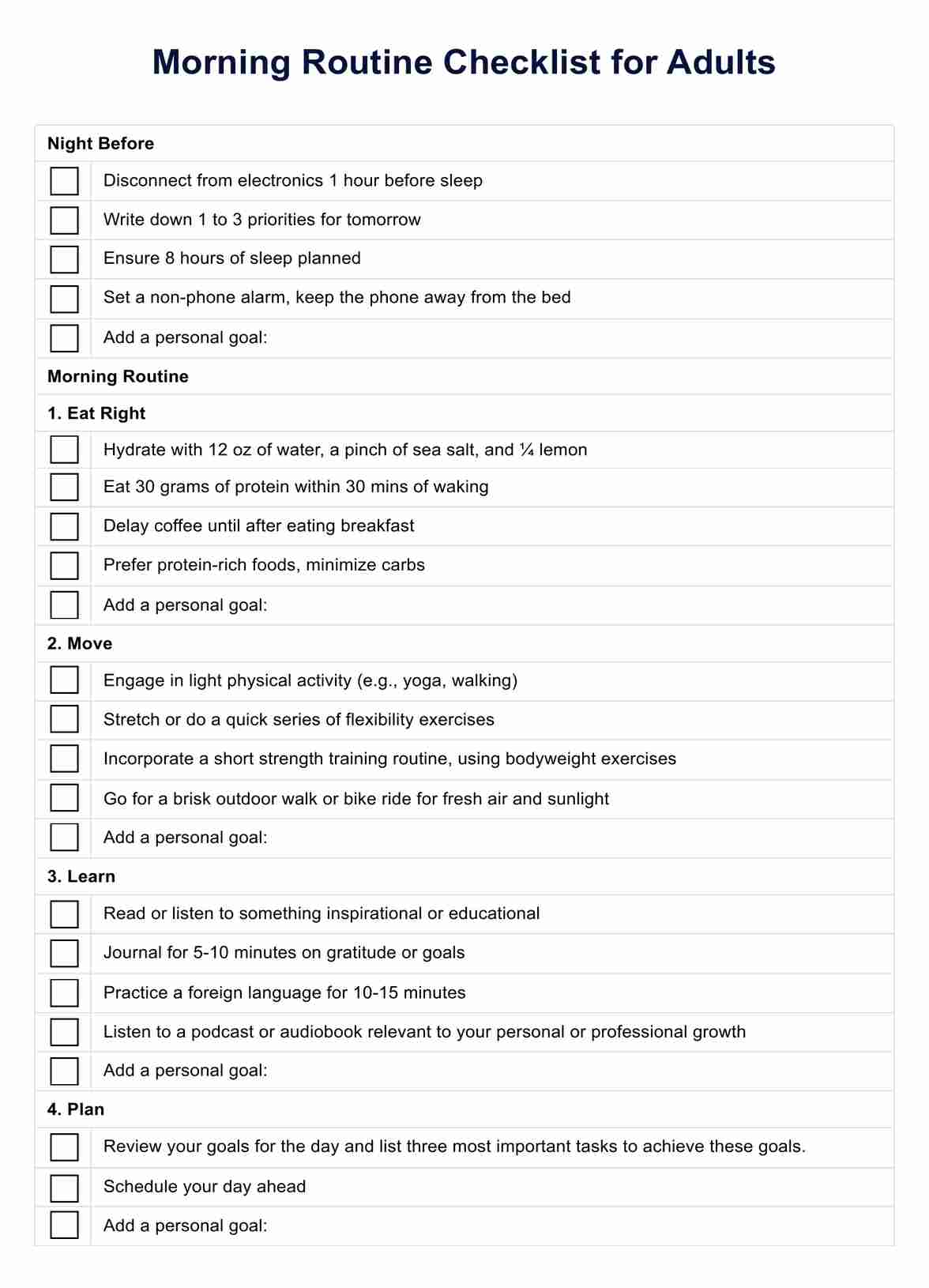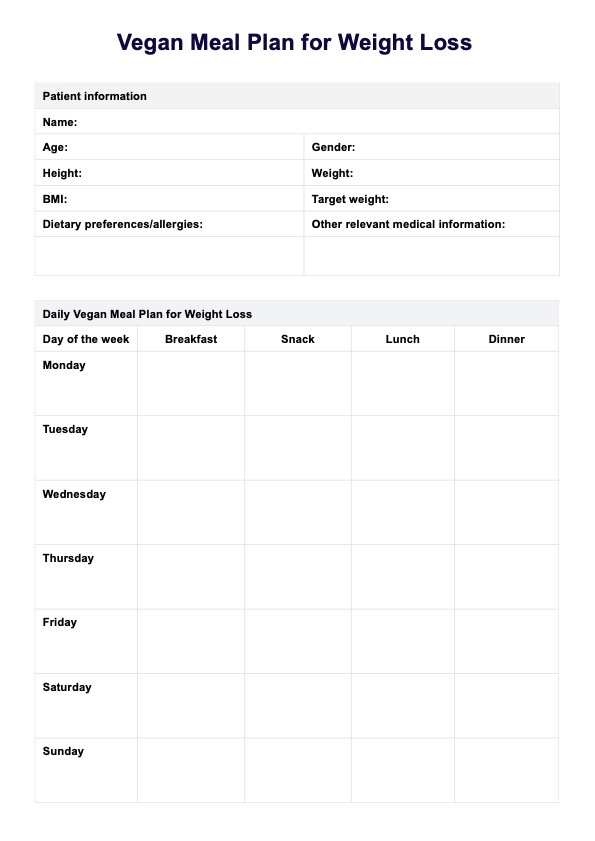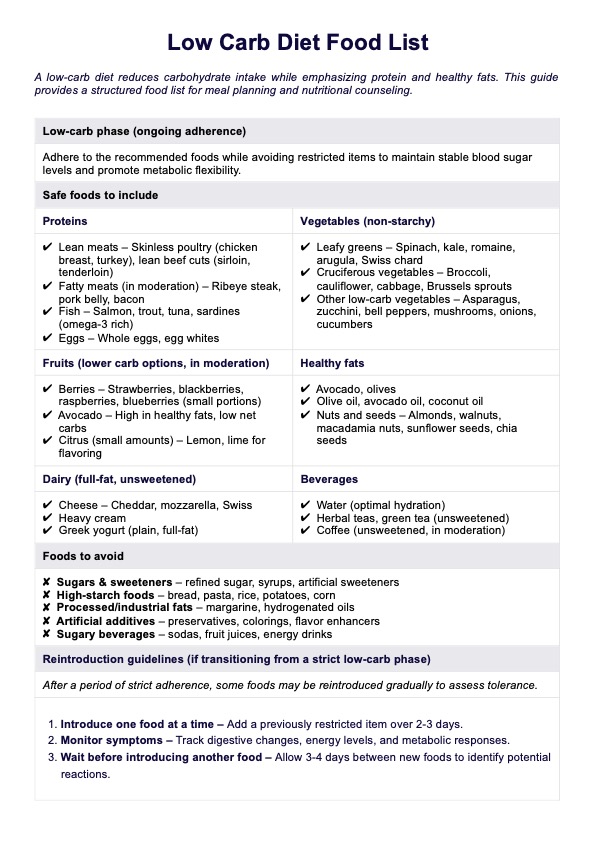Pescatarian Diet Food List
Explore the best foods for a pescatarian diet and access a free Pescatarian Diet Food List. Help clients in adopting a pescatarian lifestyle for improved health and nutrition.


What is a Pescatarian Diet Food List?
A pescatarian diet is a balanced nutritional plan wherein an individual chooses to eat fish and seafood, vegetables, fruits, whole grains, legumes, and other plant-based foods. This diet excludes red meat, meat-based products, and poultry, but other pescatarians, specifically lacto-ovo-pescatarians, may still opt to eat eggs and dairy.
Pescatarians enjoy the protein-rich benefits of eating fish and seafood, combined with the nutrient diversity of a vegetarian diet, making it a potentially healthier alternative to traditional meat-centric diets. The Pescatarian Diet leverages the nutritional benefits of fish, highlighting omega-3 fatty acids known for heart health and protein, essential for body maintenance and growth.
A Pescatarian Diet Food List can help healthcare professionals, and individuals identify the appropriate foods for this specific diet, ensuring they receive a balanced and varied intake of nutrients they usually get when they eat meat. It can also act as a guide to help in meal planning and grocery shopping for those looking to adopt a pescatarian lifestyle. It also allows individuals to be more mindful of their food choices and make informed decisions about what they eat.
Pescatarian Diet Food Template
Pescatarian Diet Food Example
How does our Pescatarian Diet Food List work?
Our free Pescatarian Diet Food List template makes creating meal plans tailored to clients' preferences and dietary requirements easier. Follow these steps to use the template:
Step 1: Download the food list
Access the free Pescatarian Diet Food List via the link provided on this page or through the Carepatron app. It's also available within our resources library from our practice management software.
Step 2: Discuss the general guidelines and list
Explain the Pescatarian Diet, its general guidelines, and why it may be beneficial for them. Go through the list of protein sources ranging from heart-healthy fish, whole grains, healthy fats, and fruits and vegetables (plant foods), and highlight any foods they particularly enjoy and any potential substitutes for any of the healthy foods they dislike.
Step 3: Create a meal plan
Refer to the Food List to create a customized meal plan for your clients based on their dietary preferences. Consider incorporating various fish sources to ensure they receive diverse nutrients and avoid processed foods like fish sticks as much as possible.
Step 4: Adjust as needed
Be open to adjusting the meal plan according to your client's feedback and any underlying health conditions. Consult with a registered dietitian or nutritionist for professional advice if needed.
When would you use this Pescatarian Diet Food List?
You can use Carepatron's Pescatarian Diet Food List as a resource for clients looking to transition to a pescatarian diet or simply incorporate more plant-based meals. Alternatively, you can use our template to:
Educate clients on the benefits of a pescatarian diet
Our Pescatarian Diet Food List is a fantastic starting point for educating clients about the many health benefits of a Pescatarian diet. You can highlight how regularly consuming fish, specifically fatty fish, healthy fats, and primarily vegetarian options, can lower the risk of heart disease by providing nutrients and supporting overall health and well-being.
Customize meal plans to suit individual preferences
With the help of this food list, you can create personalized meal plans for your clients based on their specific preferences, making it easier for them to adhere to their new diet and reach their health goals. fish
Encourage variety in meal choices
Our Pescatarian Diet Food List includes diverse options, allowing your clients to explore new foods and add variety to their meals. This can help prevent boredom and promote long-term adherence to the pescatarian diet.
Promote sustainable eating habits
You can also use this food list to educate clients about the environmental and ethical benefits of following a pescatarian diet. By including more meals from plant-based diets, your clients can contribute to reducing their carbon footprint and promoting sustainable eating habits.
Benefits of Pescatarian Diet Food List
Carepatron's easy-to-use Pescatarian Diet Food List template benefits you and your clients. Here are some of these advantages:
Fully digital
Our free template makes clinical documentation and meal planning a breeze by allowing you to access it digitally from anywhere at any time. You can also give your client a digital copy for their convenience.
Easily customizable
You can easily add or remove food items from the list to suit your client's dietary needs. This option makes catering to individual preferences easier and supports successful adherence to a pescatarian diet.
Versatile for different health goals
The Pescatarian Diet Food List can be tailored to meet various health goals, such as weight loss, improved heart health, and more. You can use it as a foundation for creating personalized meal plans that align with your client's specific health goals. greenhouse gas emissions
Nutrient-rich choices
The Pescatarian Diet Food List presents various nutrient-rich foods that can contribute to overall well-being. This list encourages a diverse and balanced plate, from fruits and vegetables packed with vitamins and minerals to fish and seafood that provide high-quality protein and heart-healthy omega-3 fatty acids.
Commonly asked questions
Pescatarian Diet Food Lists guide individuals in adopting a plant-based diet with seafood, offering various nutritious options. They benefit those transitioning to a pescatarian lifestyle for health or ethical reasons.
Pescatarian Diet Food Lists are used regularly by individuals adhering to a pescatarian diet, serving as a reference for meal planning, grocery shopping, and maintaining a balanced intake of nutrients.
The duration of following a Pescatarian Diet Food List varies. Some individuals may adopt it as a long-term dietary approach, while others may use it temporarily as they adapt to a plant-focused diet incorporating seafood.


